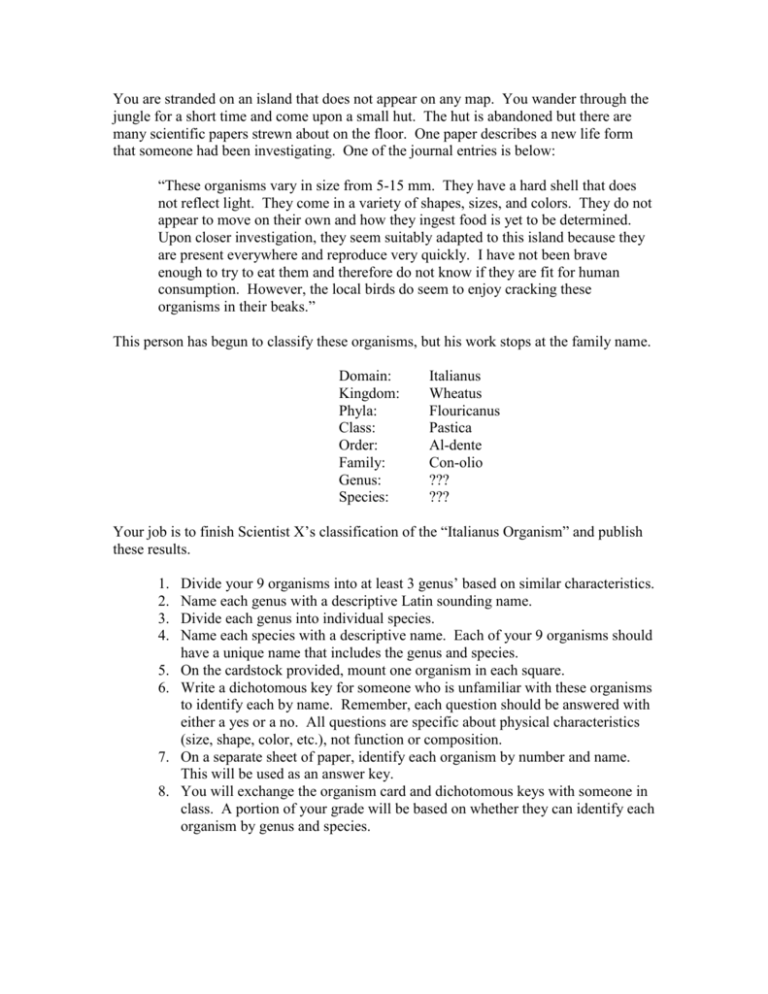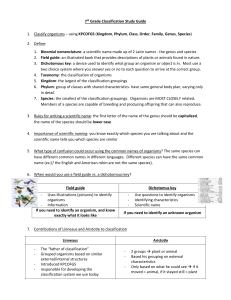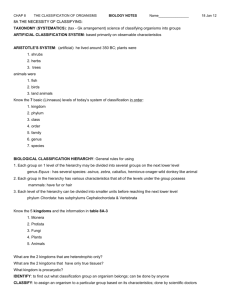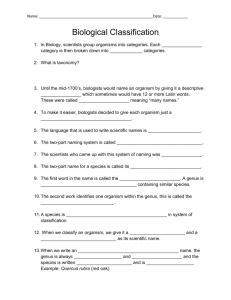Classification Exercise
advertisement

You are stranded on an island that does not appear on any map. You wander through the jungle for a short time and come upon a small hut. The hut is abandoned but there are many scientific papers strewn about on the floor. One paper describes a new life form that someone had been investigating. One of the journal entries is below: “These organisms vary in size from 5-15 mm. They have a hard shell that does not reflect light. They come in a variety of shapes, sizes, and colors. They do not appear to move on their own and how they ingest food is yet to be determined. Upon closer investigation, they seem suitably adapted to this island because they are present everywhere and reproduce very quickly. I have not been brave enough to try to eat them and therefore do not know if they are fit for human consumption. However, the local birds do seem to enjoy cracking these organisms in their beaks.” This person has begun to classify these organisms, but his work stops at the family name. Domain: Kingdom: Phyla: Class: Order: Family: Genus: Species: Italianus Wheatus Flouricanus Pastica Al-dente Con-olio ??? ??? Your job is to finish Scientist X’s classification of the “Italianus Organism” and publish these results. 1. 2. 3. 4. 5. 6. 7. 8. Divide your 9 organisms into at least 3 genus’ based on similar characteristics. Name each genus with a descriptive Latin sounding name. Divide each genus into individual species. Name each species with a descriptive name. Each of your 9 organisms should have a unique name that includes the genus and species. On the cardstock provided, mount one organism in each square. Write a dichotomous key for someone who is unfamiliar with these organisms to identify each by name. Remember, each question should be answered with either a yes or a no. All questions are specific about physical characteristics (size, shape, color, etc.), not function or composition. On a separate sheet of paper, identify each organism by number and name. This will be used as an answer key. You will exchange the organism card and dichotomous keys with someone in class. A portion of your grade will be based on whether they can identify each organism by genus and species. These organisms are fragile when removed from their environment. They will crack or break easily. Take good care of them. If you break or damage them, your grade will be reduced by 10%. Additionally, only limited amounts of samples were retrieved from the island. If you lose your sample, there are a few spare sets, however they will cost you. Your grade will be reduced by 10%. Total Points: 75 Grading Rubric: General Expectations: Organisms neatly mounted (15 pts) Answer key provided (15 pts) Dichotomous key provided (20 points) Classmate Identification: All organisms identified correctly by classmate. (25 points) 1-3 organisms identified incorrectly (15 points) 4-6 organisms identified incorrectly (10 points) 7-9 organisms identified incorrectly (0 points) Penalties: Organisms are damaged (-8) Second set of organisms needed (-8 points) Some questions in the dichotomous key are not answered yes or no (-4 points) Total:








